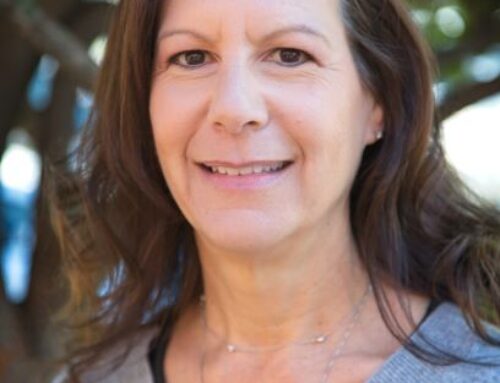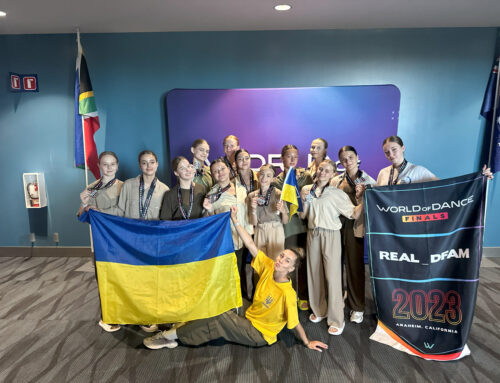Classes are six weeks long instead of 12, enabling students to catch up on their academic credits
Published in the May 25 – June 7, 2016 issue of Morgan Hill Life
By Lauren Newcomb

Photo by Marty Cheek
Juan Martinez and Jennifer Madriz create an inspirational poster in art teacher Eddy Yoon’s class at Central High School.
For the past year or so, Central High School Principal Vera Gomes has worked hard trying to manage and reshape the continuation school’s reputation, inviting members of the community to see for themselves what really happens on campus and who its students really are. The community can discover the truth about Central by attending its graduation 6 p.m. June 2 at the Downtown Amphitheater and discovering the inspiring stories of students in cap and gown who found a second chance at the school.
One of Gomes’s latest projects is working with the 2016 Leadership Morgan Hill class on the construction of a community garden that will be located on the edge of the school grounds. It’ll be a place of tranquility that anyone can come and enjoy it.
“We call it a community oasis,” she said. “This summer, my students will volunteer and any groups that want to help can volunteer. It’ll be a beautiful focal point for the community as well as for the school.”
Central’s campus is located in the Madrone district of northern Morgan Hill and has about 150 students. It has long labored under the misconception that it is the school for the “bad kids,” where the gang-bangers and the drug dealers are sent from Sobrato or Live Oak high schools. But Central is not a county court school — in fact students with criminal records are not allowed to attend. It is a continuation school that is part of the Morgan Hill Unified School District, a place where students who have fallen behind on their credits, for whatever reason, be it familial tragedies or anything else, have the opportunity to make them up and move forward with their lives with a better academic standing.

Morgan Hill Life file photo
Central High School graduates grace Downtown Amphitheater stage at last year’s graduation. At 6 p.m. June 2, about 50 students will graduate from the Morgan Hill continuation high school.
Gomes described Central’s mission as more than simply helping these students earn their diplomas. The educators are helping them figure out what they are going to do afterward. There are many different routes graduates can take, and Central tries to expose its students to all these options, including field trips to colleges, visits from industry representatives, the military and organizations like Job Corps.
“Even if you don’t know exactly what you want to do, you can get a goal, work toward it, and you can always change it,” Gomes explained. “Having that goal in place, on the horizon, that helps the students stay motivated and moving forward.”
Much of what Central does for its students is in anticipation of their futures. What comes after receiving their diploma is every bit as important as helping them earn it in the first place. Central helps them learn for life after graduation, wherever it may lead.
For Gomes, life has taken her in many directions before leading her to the school she describes as “a special place.” She began as a teacher, and for 20 years she vowed she would never cross over to what she called “the dark side”— administrative work. But life changes, and she had the opportunity to become assistant principal at Sobrato High School. She loved being able to support teachers, who, in turn, supported students.

Continuation schools have a very different structure to more traditional comprehensive high schools. The classes are six weeks long rather than the typical 12 weeks, and so the students can take more classes in a span of time. Continuation schools can also be much more accommodating for individual students, depending on what is going on in their lives and what they need at the time.
“We can build educational plans for individual students, and we have independent study programs that can help them be successful depending on their unique circumstances,” Gomes explained.
Three Central High students, Rebecca Springs, Jerry Juarez and Chris Fuentes, are considered leaders among their peers and the staff.

A student receives her diploma from Morgan Hill Unified School District board member Ron Woolf in 2015.
Photo by Marty Cheek
Springs had nothing but praise for the extra help she gets at the school. “The teachers pushed me to graduate,” she said. “If I had stayed at Live Oak, I would not be graduating. Here, I was able to focus on my credits. They go by a lot faster because they break it down, and they have their schedules figured out.”
The more streamlined and personalized setting helped Springs to succeed, whereas in a more traditional setting she fears she would not have fared so well. Fuentes and Juarez echoed her sentiments, citing the setting and the teachers as the reason they have been able to succeed.
Central’s students all have a teacher who they can trust, who they can go to with their problems. One of his favorite teacher Frank Lines, Juarez said.
“He understands the life for some of us, he understands our backgrounds. It’s hard to impress that man, and he told me I impressed him. I felt honored by that.”
Among their peers, Springs, Fuentes and Juarez are seen both as student leaders and trusted peer counselors, if not in name then at least in practice.
“I helped out an old friend,” Fuentes divulged. “Her mom died last year, and she was missing 110 credits, but I helped her lower that to 87. We’re there for anyone, to help, because we know now how the system works in the schools.”
“We’re all here for the same reason,” Springs added. “We get you. You won’t get judged.”
All three students are proud of the credits that they’ve made up since coming to Central. They’re also proud of how far they’ve come to a new path in their lives. Fuentes and Juarez will be graduating in June, and moving on to the Army and Gavilan College, respectively. Springs will be graduating in August.
“If people are coming to this school, it’s not a school to be scared of. We’re not mean, and we’re not gang-bangers,” Springs said. “Actually, I wouldn’t have minded coming here my freshman year.”
One of the teachers at Central, Nicole Dietmeier, said that her favorite thing about teaching at Central is the relationships she builds with her students — and helping them find whatever it takes inside themselves to graduate.
“These are at-risk kids, and to see them flourish and succeed when they come here — and then graduate! It’s really neat to see,” she said.
Before instructing at Central, Dietmeier taught at Live Oak. There, she couldn’t always focus on individual students because of the larger class sizes and the format of comprehensive schools. Because of those factors, she couldn’t help all of the students at Live Oak.
“We know kids are coming to us with struggles and with holes in their education, no matter what the subject is,” Dietmeier said. “If we are going over a concept, be it writing or math or anything else, and we see that hole, we can pull them aside and provide deeper support for them.”
She appreciates having the ability and the opportunity to sort these problems out at Central.
Eddy Yoon, the art teacher, follows the philosophy of teaching to one’s audience. For that reason, his lessons look different from first period, to second, to sixth, because each group of students is different.
“Each class comes with a different dynamic, a different energy, so you can’t present your information the same way and expect the same results,” he said. “I’ve learned that the hard way. You have to see where the students are at, what they’re capable of, and meet them halfway.”
Yoon admires the way that the playing field is more even here and how the students all have something in common — the fact that they’ve come here to recover credits. This creates a camaraderie among the students that might have been simply raw competition at a comprehensive high school.
“When they see a peer in the classroom being successful, they are thinking, ‘If they can do it, why can’t I do it?’ Sometimes I see their intrinsic motivation come from seeing their peers be successful in the school,” Yoon explained.
Central High School is Yoon’s first career teaching position, and he’s proud of his school. “We’re the home of the Eagles and this is my nest,” he said. “This is where I hatched. My feathers are from this school.”
His metaphor might be perfectly suited to Central and its students, too. Clearly, this is where young people have found a second chance, have flourished despite what life has thrown at them and are now looking forward to their futures.
Central is the home of the Eagles, but perhaps there’s something of the phoenix in them, too.









